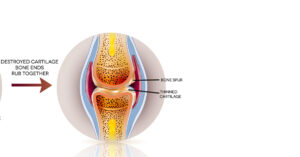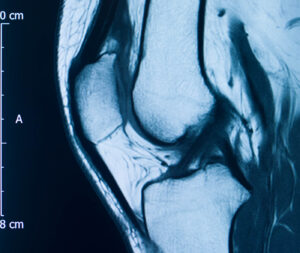Knee Pain
What is a Bone Spur? And How Do I Know if I Have One?
Most people have heard of a bone spur (or osteophyte). But, they don’t know exactly what it is – or how to tell if they have one. If you’re curious, here’s everything you need to know:
Osteoarthritis and Bone Spur Development
Osteoarthritis. Osteoarthritis is the most common form of arthritis. The condition, which usually affects patients over 50, causes the cartilage and soft tissue of the body’s joints to wear away. As wearing occurs, the cartilage thins and becomes frayed and rough. Eventually, cartilage will wear away completely or be torn, which causes bone-on-bone rubbing. Cartilage is very smooth and intact cartilage on cartilage is smoother than ice gliding on ice. Bone rubbing on bone has high friction and becomes painful as it catches with motion.

Illustration 1- An osteophyte (also known as a bone spur)

Illustration 2- An osteophyte as seen on an x-ray
Bone spur development. Bone-on-bone rubbing causes bones to become irritated and inflamed. In order to protect themselves, bones will form new, hard pieces of bone. Because bone spurs protrude into the joint, they can be extremely painful and limit mobility.
Diagnosing and Treating a Bone Spur
In order to determine if patients with knee pain have a bone spur, they need to see an orthopedic specialist. During an appointment with an orthopedic specialist, the following will occur:
- A detailed medical history will be taken. Pre-existing conditions and/or injuries give clues regarding the development of osteoarthritis.
- A thorough physical examination will be performed. Knee joint mobility and muscle flexibility and strength will be checked.
- Medical imaging studies will be ordered and read. X-rays and/or MRIs are used to identify bone spurs as well as cartilage degeneration.
- A formal diagnosis will be made. The diagnosis of a bone spur helps the orthopedic doctor come up with an appropriate treatment plan.
Bone spur treatment depends on the type of spur and its location. Non-surgical treatment options are always tried first. Activity modification, ice, medications, injections and physical therapy can all be helpful.
If the symptoms of osteoarthritis and a bone spur don’t go away after conservative treatment, an orthopedic surgical procedure may be necessary. This is something that’s best discussed with the orthopedic specialist treating the condition.
Seeking Treatment
If you have knee osteoarthritis and are in pain, it might be because of a bone spur. Please contact one of our 5 Long Island offices to find out if it is. We’re currently accepting new patients and will get you in ASAP.
The physicians at Total Orthopedics and Sports Medicine focus on both the surgical and non-surgical treatment of bone and joint injuries. Renowned experts Dr. Charles Ruotolo, Dr. Richard McCormack, Dr. Brett Spain and Dr. Paul Pipitone lead our Knee Team. Fortunately, many patients can be treated non-surgically with a combination of conservative modalities coordinated by the Total Orthopedics and Sports Medicine Team. If surgery is necessary, the practice uses a multidisciplinary approach to create a treatment plan that focuses on the patient’s lifestyle and activities and helps them get back to those activities quickly and effectively. When in the hands of one of our expert Long Island Orthopedic Surgeons, a full recovery is possible!







 Website Design by
Website Design by